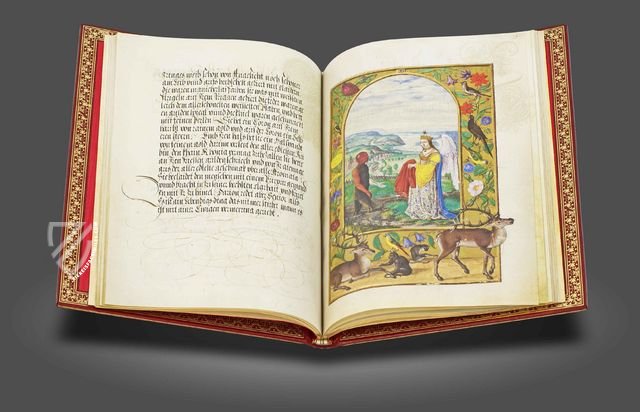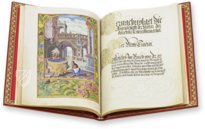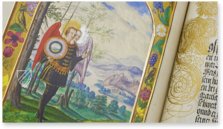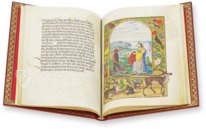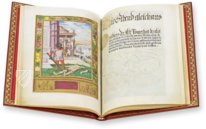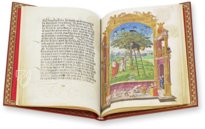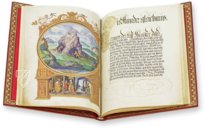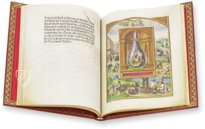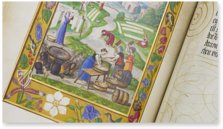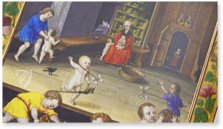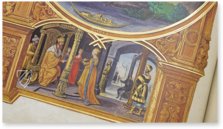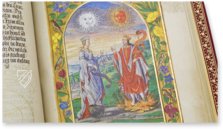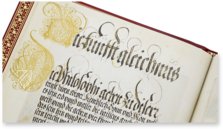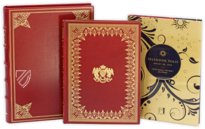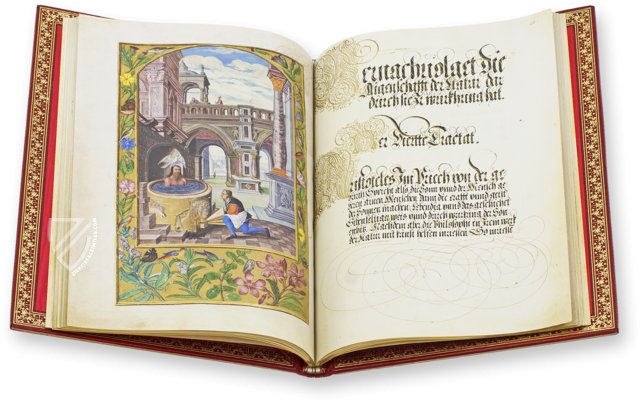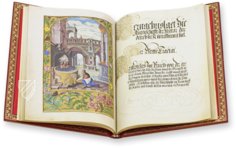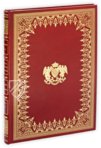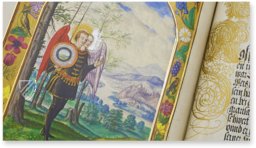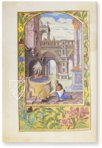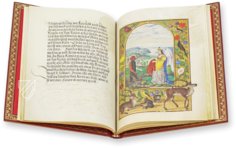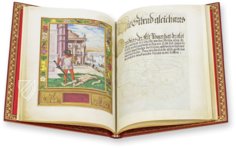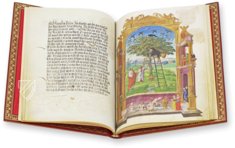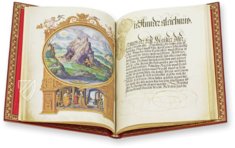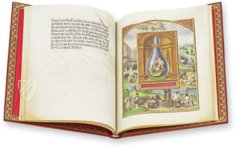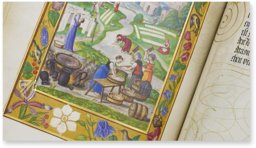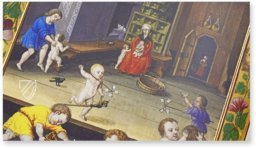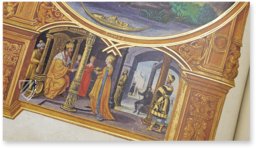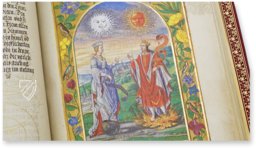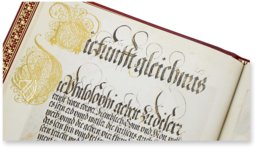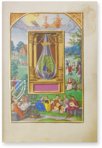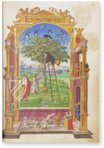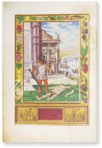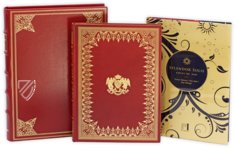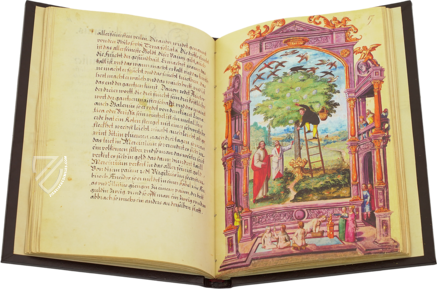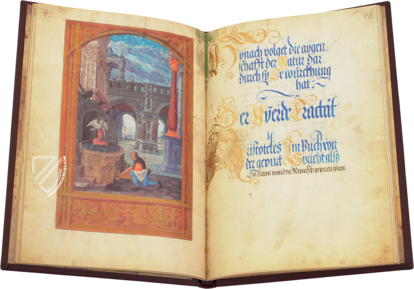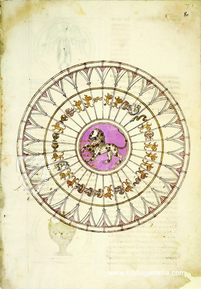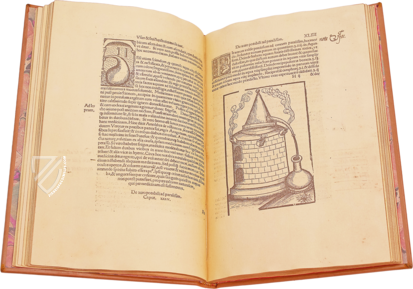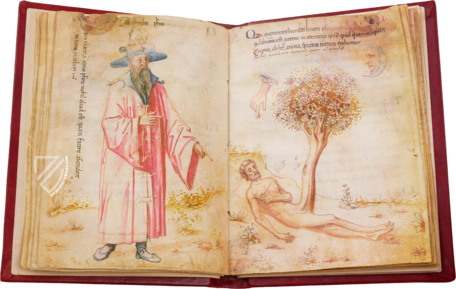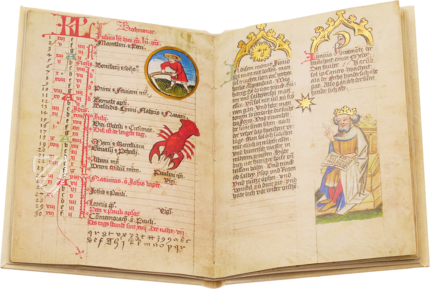London Splendor Solis
(3,000€ - 7,000€)
The most beautiful treatise on the science of Alchemy that was ever written is adorned with 22 large and colorful miniatures: this fine specimen of the Splendor Solis arose ca. 1440 in Germany and was illuminated by the Renaissance alchemist Ulrich von Poysel, better known as Salomon Trismosin. Allegorical miniatures show mysterious images in glass bulbs surrounded by scenes from life in late medieval Germany and include images of pagan gods and goddesses. These wonderful scenes are brought to life by a bright color palette and generously applied gold leaf while the refinement of their execution distinguishes this specimen from other similar manuscripts. This highly coveted masterpiece of the Northern Renaissance passed through many hands throughout its existence, a further testament to the sophistication of its artistry and the alluring nature of its enigmatic text. Despite this eventful ownership history, the manuscript survives in remarkably excellent condition today.
London Splendor Solis
Alchemy was a medieval science that preceded modern chemistry and pharmacology. Among the aims of the alchemists was the production of gold, silver, and other precious metals. The legendary “Philosopher’s Stone” is supposed to have served that purpose. The Splendor Solis codex is the most beautiful illuminated manuscript that was written about the science of alchemy. The manuscript, which discusses the fundamental questions of the themes of religion, astrology, and alchemistic symbolism, is adorned with 22 splendid full-page illustrations.
A Philosophical Marvel
The incorporable treatise was probably written by Ulrich von Poysel, who worked under the pseudonym Salomon Trismosin. Poysel was a teacher of the famous humanist scholar Paracelsus. In the Splendor Solis, Poysel explains in cryptic poetry the natural elements, their combinations, their mixtures, their abilities, and their influence on the life of his contemporaries. The mystic gained his comprehensive knowledge from the magical works of the Kabbala, among other others, as he said himself.
Encrypted Miniatures
A particularly conspicuous characteristic of the codex is its 22 astonishing, large-format miniatures. The pictures, which are framed by various motifs of animals or flowers, are small allegorical masterpieces, which cannot be deciphered at first glance. One miniature of the work already enjoyed special fame in the Middle Ages. The depiction of the glass bulbs, which were employed in the alchemistic work processes, still evokes astonishment and wonder from its beholders today. Within each glass bulb mysterious, fantastical marvels were depicted and the bulbs are embedded in paintings of rural life in late medieval Germany. Floating above the scene is an all-dominating pagan deity that appears to influence the events within the glass bulbs. The fantastical miniatures are a reason why the codex also amazes readers unfamiliar with the subject.
The History of the Work
John Evelyn, painter at the English court of King Charles II, was one of the first people who wrote about the exceptional treatise. He saw the codex in September of 1680 in the library of Whitehall Palace, as his records reveal. He relates on the subject that it contained “the processes for the greatest elixir of the philosophers” and is embellished with inconceivably beautiful illustrations. Later, the masterpiece came into the possession of the German theologian Johann Cyprianus and was eventually acquired by the influential aristocratic Harley family. The Harley’s were known as patrons of the arts and lovers of books. Today the splendid treatise is one of the greatest treasures of the British Library in London.
Codicology
- Alternative Titles
- Splendor Solis - Sonnenglanz
- Size / Format
- 100 pages / 32.0 × 22.0 cm
- Origin
- Germany
- Date
- 1582
- Epochs
- Style
- Language
- Script
- Gothic
- Illustrations
- 22 full-page miniatures
- Content
- The Splendor Solis, an important treatise on alchemy written at the dawn of modern science, consists of text accompanied by a series of elaborate images set in ornamental borders and niches similar in style to the decorative borders used in book of hours
- Artist / School
- Probably Salomon Trismosin (= Ulrich Poysel, teacher of Paracelsus) (author)
- Previous Owners
- Charles II of England
Johann Cyprianus
Edward Harley and his wife
London Splendor Solis (Harley 4369)
A Bathing Alchemist
Like most alchemical manuscripts, this German Renaissance work is filled with allegorical imagery in order to guard alchemy’s secrets from the uninitiated. An attendant fans the flames of a large brick bath wherein a bearded man is seated with a white dove on his head symbolizing the cleansing of the soul. The scene is a metaphor for the albedo, a stage of purification for both substances and for the purification of one’s soul to restore it to its original state of purity and receptivity.
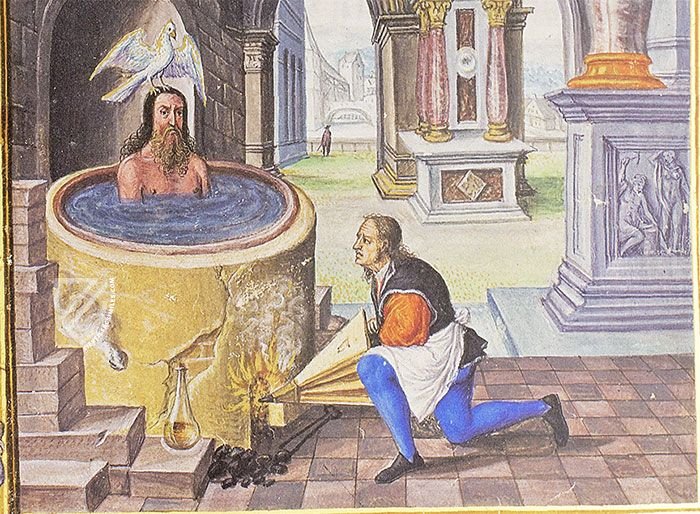
London Splendor Solis
Venus
Venus is associated with the pleasures of life, all that is joyous and beautiful, and is pictured being driven by a pair of doves and symbolized by a winged heart pierced by an arrow. She reigns over a scene of merriment: horseback rides, dancing, lovers embracing one another, the playing of music, the recitation of poetry, and the drinking of wine.
The peacock was one of the most important symbols of medieval Europe, and depending on the context could represent either vain pride or noble grace. Furthermore, its meat was believed to be an aphrodisiac that increased male potency. For alchemists, its plumage that seems to change color depending upon the light was yet another symbol of the transmutation that lay at the heart of their esoteric art.
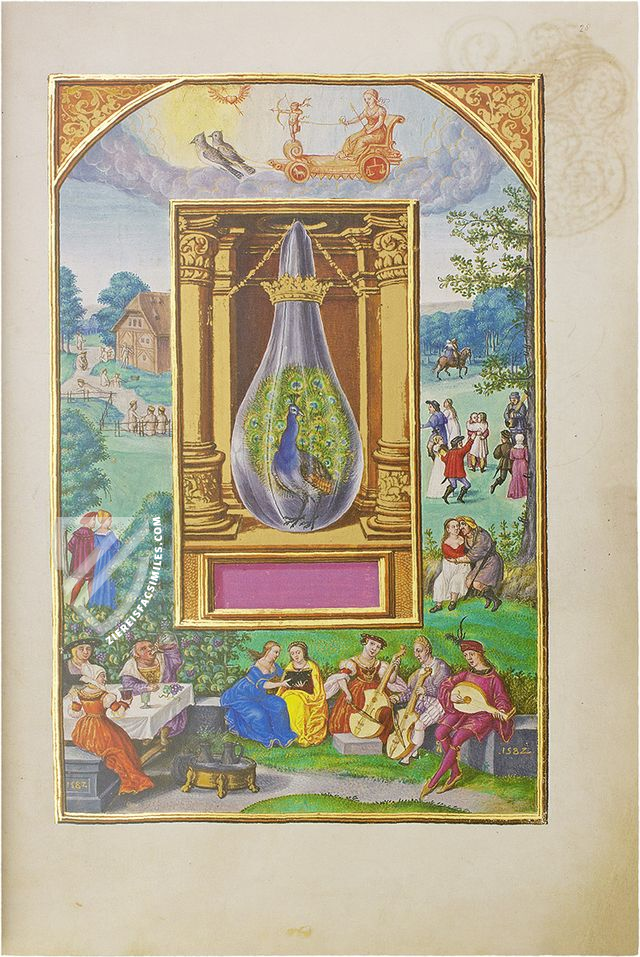
#1 Splendor Solis
Language: English, Spanish
(3,000€ - 7,000€)
- Treatises / Secular Books
- Apocalypses / Beatus
- Astronomy / Astrology
- Bestiaries
- Bibles / Gospels
- Chronicles / History / Law
- Geography / Maps
- Saints' Lives
- Islam / Oriental
- Judaism / Hebrew
- Single Leaf Collections
- Leonardo da Vinci
- Literature / Poetry
- Liturgical Manuscripts
- Medicine / Botany / Alchemy
- Music
- Mythology / Prophecies
- Psalters
- Other Religious Books
- Games / Hunting
- Private Devotion Books
- Other Genres
- Afghanistan
- Armenia
- Austria
- Belgium
- Belize
- Bosnia and Herzegovina
- China
- Colombia
- Costa Rica
- Croatia
- Cyprus
- Czech Republic
- Denmark
- Egypt
- El Salvador
- Ethiopia
- France
- Germany
- Greece
- Guatemala
- Honduras
- Hungary
- India
- Iran
- Iraq
- Israel
- Italy
- Japan
- Jordan
- Kazakhstan
- Kyrgyzstan
- Lebanon
- Liechtenstein
- Luxembourg
- Mexico
- Morocco
- Netherlands
- Palestine
- Panama
- Peru
- Poland
- Portugal
- Romania
- Russia
- Serbia
- Spain
- Sri Lanka
- Sweden
- Switzerland
- Syria
- Tajikistan
- Turkey
- Turkmenistan
- Ukraine
- United Kingdom
- United States
- Uzbekistan
- Vatican City
- A. Oosthoek, van Holkema & Warendorf
- Aboca Museum
- Ajuntament de Valencia
- Akademie Verlag
- Akademische Druck- u. Verlagsanstalt (ADEVA)
- Aldo Ausilio Editore - Bottega d’Erasmo
- Alecto Historical Editions
- Alkuin Verlag
- Almqvist & Wiksell
- Amilcare Pizzi
- Andreas & Andreas Verlagsbuchhandlung
- Archa 90
- Archiv Verlag
- Archivi Edizioni
- Arnold Verlag
- ARS
- Ars Magna
- ArtCodex
- AyN Ediciones
- Azimuth Editions
- Badenia Verlag
- Bärenreiter-Verlag
- Belser Verlag
- Belser Verlag / WK Wertkontor
- Benziger Verlag
- Bernardinum Wydawnictwo
- BiblioGemma
- Biblioteca Apostolica Vaticana (Vaticanstadt, Vaticanstadt)
- Bibliotheca Palatina Faksimile Verlag
- Bibliotheca Rara
- Boydell & Brewer
- Bramante Edizioni
- Bredius Genootschap
- Brepols Publishers
- British Library
- C. Weckesser
- Caixa Catalunya
- Canesi
- CAPSA, Ars Scriptoria
- Caratzas Brothers, Publishers
- Carus Verlag
- Casamassima Libri
- Centrum Cartographie Verlag GmbH
- Chavane Verlag
- Christian Brandstätter Verlag
- Circulo Cientifico
- Club Bibliófilo Versol
- Club du Livre
- CM Editores
- Collegium Graphicum
- Collezione Apocrifa Da Vinci
- Comissão Nacional para as Comemorações dos Descobrimentos Portugueses
- Coron Verlag
- Corvina
- CTHS
- D. S. Brewer
- Damon
- De Agostini/UTET
- De Nederlandsche Boekhandel
- De Schutter
- Deuschle & Stemmle
- Deutscher Verlag für Kunstwissenschaft
- DIAMM
- Droz
- E. Schreiber Graphische Kunstanstalten
- Ediciones Boreal
- Ediciones Grial
- Ediclube
- Edições Inapa
- Edilan
- Editalia
- Edition Deuschle
- Edition Georg Popp
- Edition Leipzig
- Edition Libri Illustri
- Editiones Reales Sitios S. L.
- Éditions de l'Oiseau Lyre
- Editions Medicina Rara
- Editorial Casariego
- Editorial Mintzoa
- Editrice Antenore
- Editrice Velar
- Edizioni Edison
- Egeria, S.L.
- Eikon Editores
- Electa
- Emery Walker Limited
- Enciclopèdia Catalana
- Eos-Verlag
- Ephesus Publishing
- Ernst Battenberg
- Eugrammia Press
- Extraordinary Editions
- Fackelverlag
- Facsimila Art & Edition
- Facsimile Editions Ltd.
- Facsimilia Art & Edition Ebert KG
- Faksimile Verlag
- Feuermann Verlag
- Folger Shakespeare Library
- Franco Cosimo Panini Editore
- Friedrich Wittig Verlag
- Fundación Hullera Vasco-Leonesa
- G. Braziller
- Gabriele Mazzotta Editore
- Gebr. Mann Verlag
- Gesellschaft für graphische Industrie
- Getty Research Institute
- Giovanni Domenico de Rossi
- Giunti Editore
- Graffiti
- Grafica European Center of Fine Arts
- Guido Pressler
- Guillermo Blazquez
- Gustav Kiepenheuer
- H. N. Abrams
- Harrassowitz
- Harvard University Press
- Helikon
- Hendrickson Publishers
- Henning Oppermann
- Herder Verlag
- Hes & De Graaf Publishers
- Hoepli
- Holbein-Verlag
- Houghton Library
- Hugo Schmidt Verlag
- Idion Verlag
- Il Bulino, edizioni d'arte
- ILte
- Imago
- Insel Verlag
- Insel-Verlag Anton Kippenberger
- Instituto de Estudios Altoaragoneses
- Instituto Nacional de Antropología e Historia
- Introligatornia Budnik Jerzy
- Istituto dell'Enciclopedia Italiana - Treccani
- Istituto Ellenico di Studi Bizantini e Postbizantini
- Istituto Geografico De Agostini
- Istituto Poligrafico e Zecca dello Stato
- Italarte Art Establishments
- Jan Thorbecke Verlag
- Johnson Reprint Corporation
- Josef Stocker
- Josef Stocker-Schmid
- Jugoslavija
- Karl W. Hiersemann
- Kasper Straube
- Kaydeda Ediciones
- Kindler Verlag / Coron Verlag
- Kodansha International Ltd.
- Konrad Kölbl Verlag
- Kurt Wolff Verlag
- La Liberia dello Stato
- La Linea Editrice
- La Meta Editore
- Lambert Schneider
- Landeskreditbank Baden-Württemberg
- Leo S. Olschki
- Les Incunables
- Liber Artis
- Library of Congress
- Libreria Musicale Italiana
- Lichtdruck
- Lito Immagine Editore
- Lumen Artis
- Lund Humphries
- M. Moleiro Editor
- Maison des Sciences de l'homme et de la société de Poitiers
- Manuscriptum
- Martinus Nijhoff
- Maruzen-Yushodo Co. Ltd.
- MASA
- Massada Publishers
- McGraw-Hill
- Metropolitan Museum of Art
- Militos
- Millennium Liber
- Müller & Schindler
- Nahar - Stavit
- Nahar and Steimatzky
- National Library of Wales
- Neri Pozza
- Nova Charta
- Oceanum Verlag
- Odeon
- Orbis Mediaevalis
- Orbis Pictus
- Österreichische Staatsdruckerei
- Oxford University Press
- Pageant Books
- Parzellers Buchverlag
- Patrimonio Ediciones
- Pattloch Verlag
- PIAF
- Pieper Verlag
- Plon-Nourrit et cie
- Poligrafiche Bolis
- Presses Universitaires de Strasbourg
- Prestel Verlag
- Princeton University Press
- Prisma Verlag
- Priuli & Verlucca, editori
- Pro Sport Verlag
- Propyläen Verlag
- Pytheas Books
- Quaternio Verlag Luzern
- Reales Sitios
- Recht-Verlag
- Reichert Verlag
- Reichsdruckerei
- Reprint Verlag
- Riehn & Reusch
- Roberto Vattori Editore
- Rosenkilde and Bagger
- Roxburghe Club
- Salerno Editrice
- Saltellus Press
- Sandoz
- Sarajevo Svjetlost
- Schöck ArtPrint Kft.
- Schulsinger Brothers
- Scolar Press
- Scrinium
- Scripta Maneant
- Scriptorium
- Shazar
- Siloé, arte y bibliofilia
- SISMEL - Edizioni del Galluzzo
- Sociedad Mexicana de Antropología
- Société des Bibliophiles & Iconophiles de Belgique
- Soncin Publishing
- Sorli Ediciones
- Stainer and Bell
- Studer
- Styria Verlag
- Sumptibus Pragopress
- Szegedi Tudomànyegyetem
- Taberna Libraria
- Tarshish Books
- Taschen
- Tempus Libri
- Testimonio Compañía Editorial
- Thames and Hudson
- The Clear Vue Publishing Partnership Limited
- The Facsimile Codex
- The Folio Society
- The Marquess of Normanby
- The Richard III and Yorkist History Trust
- Tip.Le.Co
- TouchArt
- TREC Publishing House
- TRI Publishing Co.
- Trident Editore
- Tuliba Collection
- Typis Regiae Officinae Polygraphicae
- Union Verlag Berlin
- Universidad de Granada
- University of California Press
- University of Chicago Press
- Urs Graf
- Vallecchi
- Van Wijnen
- VCH, Acta Humaniora
- VDI Verlag
- VEB Deutscher Verlag für Musik
- Verlag Anton Pustet / Andreas Verlag
- Verlag Bibliophile Drucke Josef Stocker
- Verlag der Münchner Drucke
- Verlag für Regionalgeschichte
- Verlag Styria
- Vicent Garcia Editores
- W. Turnowski Ltd.
- W. Turnowsky
- Waanders Printers
- Wiener Mechitharisten-Congregation (Wien, Österreich)
- Wissenschaftliche Buchgesellschaft
- Wissenschaftliche Verlagsgesellschaft
- Wydawnictwo Dolnoslaskie
- Xuntanza Editorial
- Zakład Narodowy
- Zollikofer AG

